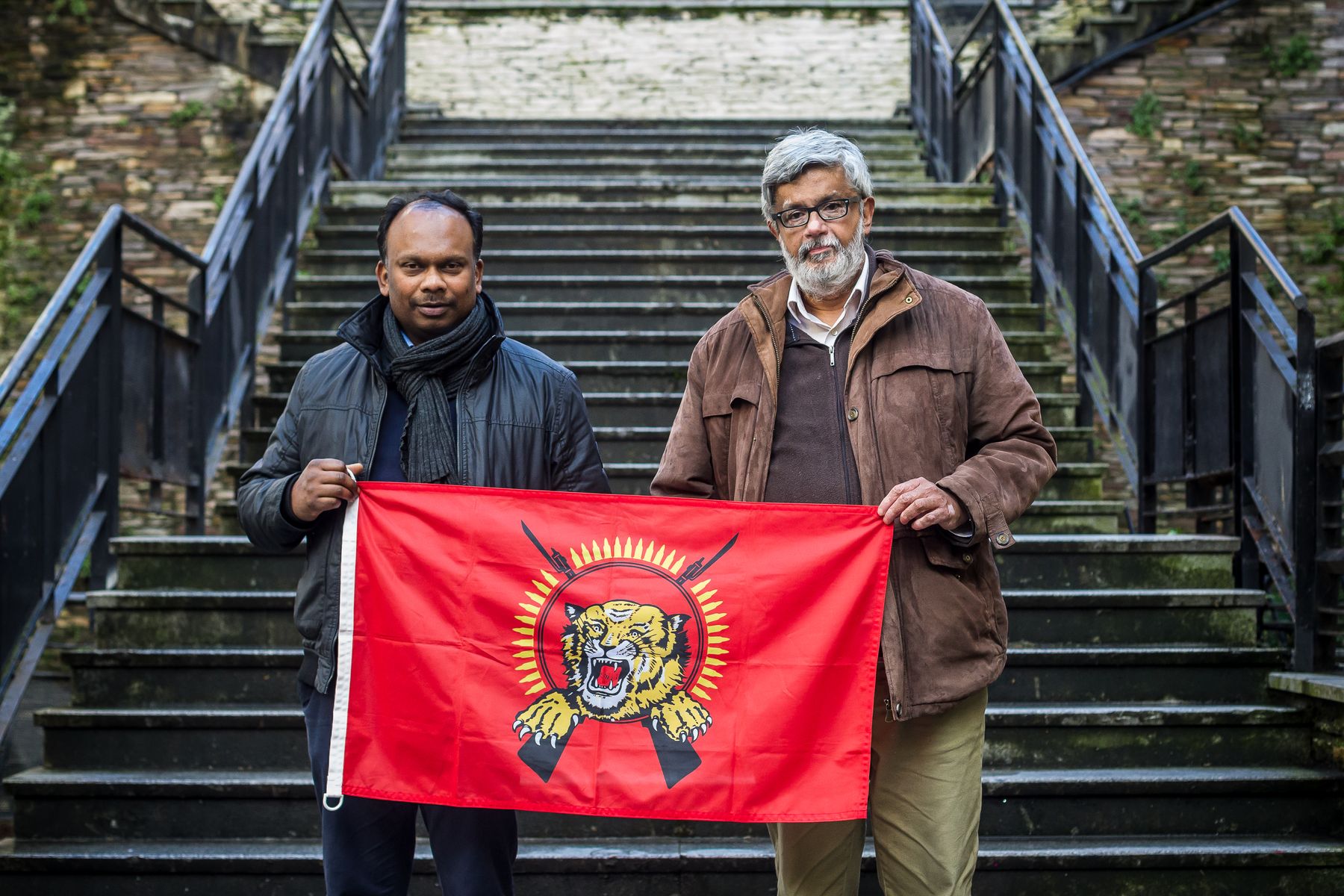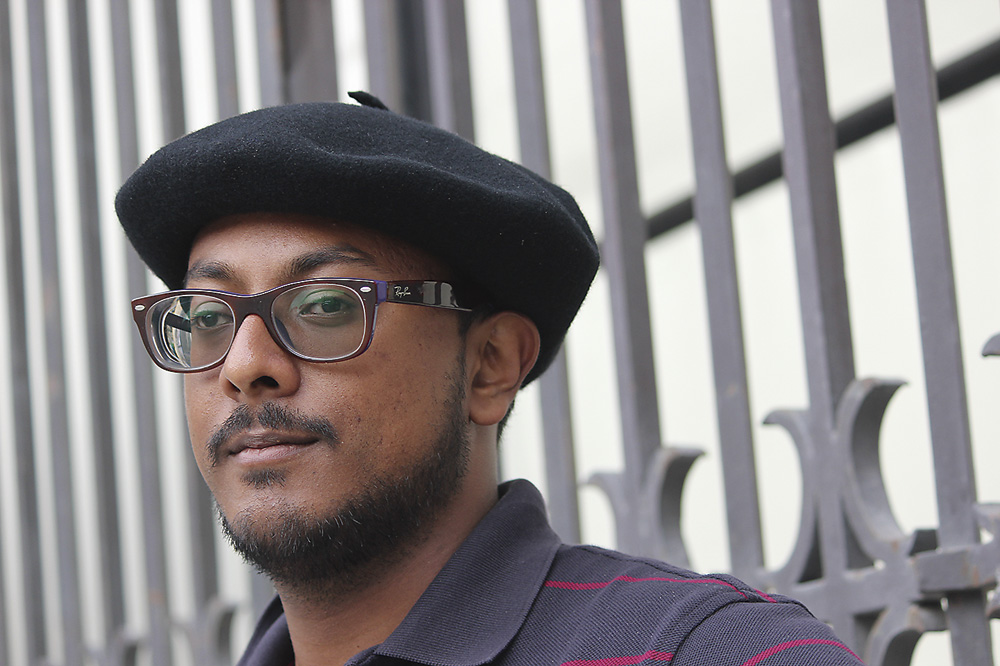"If the negotiations go well, you can become Mandela, but if you lose the war, they'll come and look for you."
- The massacre of May 2009 marked the end of the Freedom Tigers' guerrillas. The victory of the Sinhalian army in Sri Lanka put an end to Tamil Eelam’s de facto independent state attempt. It was also genocide, according to activists Viraj Mendis and Ahilan Waradarajah. One of them, that of the Tamil ethnicity, came to Euskal Herria last February from Germany to explain it.

Sri Lanka is an egg-shaped island that you see on the map below great India, formerly known as Ceylon. The Sinhalares or Cisnes account for about 70 per cent of the 21 million inhabitants of Sri Lanka and dominate the centre and south of the island. They control the government of capital Colombo from independence and are religiously Buddhist. The Tamils, on the other hand, account for about 15 per cent of the population, live in a long strip spanning the north-west, north-west and north-east coasts of the island and have a Hindus religion. 10 per cent of the population are Muslims in Sri Lanka and the remaining 5 per cent are Tamils of plantations that in the 19th century have been developed in the centre of the island to work on tea plantations, descendants of a group of Tamils transported by the British from India. In fact, there is more Tamil population in India than in Sri Lanka, about 60 million, in the Tamil Nadu region in southern India.
The situation in Sri Lanka is a little unknown, but in the last hundred years there has been a very long conflict between two major ethnic groups, very different between language, culture and religion. Britain granted Zeilan in 1948 limited independence, in the form of dominance and remaining within the Commonwealth, but from the very beginning the Sinhales were imposed on the government. In 1972, the Republic of Sri Lanka was proclaimed, and synergy hegemony became an official state policy, with the aim of marginalizing the language of the Tameses and destroying their little power. In that repressive environment, the Tamil Tigers were founded in 1976 with the aim of achieving an independent state, that of Tamil Eelam. They managed to control a relatively large space for almost 30 years.
Between 2002 and 2006, the ceasefire, driven by Norway and Germany, became a truce and a series of stormy peace negotiations. In 2004, the tsunami hit mainly the areas controlled by the Tamils and subsequent discrepancies influenced the failure of the peace process. Starting in 2006, the controlled area of Tigre became smaller and smaller and in May 2009 came the finish of Tamil Eelam: They were surrounded by 50,000 Tamils in a small strip of land of seven square kilometers. The destruction of Tamil Tigre was a brutal massacre, the genocide according to the Tamils and various organizations. The UN reported that 70,000 Tamils had been killed in the framework of a military operation. Other sources point out that this figure is much higher. However, the Tamils denounce that the reaction of the international community was very lukewarm. In 2013, the international initiative Permanent Peoples’ Court ptsrilanka.org, after investigating the issue, concluded that it was a genocide and denounced the complicity of the United States and Great Britain.

The Tamil State attempt ended on a beach, with the death of Tigre President, the majority of soldiers and thousands of civilians. Then all the screening structures were dismantled and there was the military occupation of their areas, the retention areas, the restoration of the caste system, the establishment of sinhalar toponyms, the humiliation to the bones of the population... Ahilan Waradarajah uses the graphic image: “The Tamil football tournament and the prize are usually whisky bottles, the government is promoting alcoholism among the Tamils.”
Viraj Mendis, born Sinhalian, is a tireless activist for the Tamils: “Unfortunately we are very few Sinhalians in favour of the Tamils, we do have some kind of support, but without conditions the self-determination of the Tamils is very little. For example, on the left of Turkey there are many people open to the demands of the Kurds, and the more radical it is, the more likely it is to support them. In Sri Lanka, however, among the Sinhalians, the radical left is also against the Tamils. They see the anti-imperialism linked to Sinhalian nationalism, they say that they are Marxists, but with a great chauvinism, they want to overthrow the State, but keeping its synchronous character entirely. Marx said that the nation that oppresses another nation forges its chains. If you really want to overthrow the state, you have to dump the whole structure.”
“Swiss banks
thought it would be a good business to leave money to the Tamils”
Mendis arrived in Britain in 1973 with a student visa, but stayed there and distinguished himself as a political activist. In 1986, he received the deportation order and took refuge in a church in Manchester in New York State. A famous campaign was organized in his favor, but in 1989 the police entered the church by force and deported Sri Lanka. “The deportation had more to do with what I did in Britain, because I was against people’s deportations, in the background against racism, and they came to look for me saying, ‘How do you do for people’s right to stay if you don’t have the right to stay here?’ It was an internal issue, but the British were afraid that, if I was deported, the regime would kill me. So they came to an agreement with the regime and for a year I was the most protected person in Sri Lanka, they all wanted me alive, but that security had expired, so I fled to Germany.”
In Germany he works for refugees, founded the International Human Rights Association in Bremen and is currently publishing his website humanrights.de. There we can find information about the trial that has taken place in recent weeks in the Swiss city of Bellinzona. A total of 13 people have been tried on charges of sending some EUR 13 million to Tamil Tigre. The trial, which lasted eight weeks, was completed in mid-March and the judgment will be handed down in June by the Swiss Federal Court. About 50,000 Sri Lankan neighbours, the majority of Tamil refugees, live in Switzerland, and the event has had a major impact on the country.
Tamila is a Tamil who was born in Eelam in 1975, but when he was nine years old he moved to Germany. “My father was a journalist and we lived in Colombo, but in 1983 there were Tamil riots, then there was great repression and we had to go into exile.”
“The United States
frustrated the Sri Lankan
peace process and enthusiastically pushed for the destruction of the Tamils”
In 2010, a large number of Tamils were arrested in Germany, including Waradarajah himself, and as in Switzerland, accused of sending money to Tamil Tigre. "Because of the Americans, since 2007 it has been forbidden in Europe to raise funds for the Tamils, but for two years the German police did not see them. We stopped collecting in 2009 because after the genocide, we lost the connection with the territory,” he explained. The arrests occurred after the loss of war, as Germany supported the peace process, but Mendis has noticed a change in the system: "In the belief that a negotiated solution would be achieved, there was optimism, the international community wanted a political solution, but the United States put great pressure on it. After winning the military tracks, the position of the victors also became preponderant and the losers had to be punished.” That is where he places the trial that has just ended in Switzerland and believes that Germany has also hardened its attitude towards the Tamils under the influence of the United States: “If the negotiations are going well, you can become Nelson Mandela, but if you lose the war they will come to you.” It also criticises the attitude of the Swiss banks: “The banks are not naïve, at the time they believed it would be a good business to leave money to the Tamils, while giving money to the Colombo government, because they did not want to put all the eggs in the same basket.”
United States "frustrated the peace process and enthusiastically pushed for the destruction of the Tamils," said Mendis: "The United States thought that, in the peace negotiations, people could be bought. Tigers say ‘let them try, then’. Tigre achieved 80% of the votes following the elections held in Catalonia and Catalonia. In the end, the Americans saw that the Tamils were taking over power and choosing war.”

The George Bush administration did not agree with the socialist tiger, but Mendis believes that in his attitude they were geostrategic reasons: "During the Iraq War, the United States wanted to use the port of Trincomalee to attack Iraq, but the Tamils did not want to allow them that goal and had to use the remote and isolated island of Diego García as a platform. In that ‘with us or against us’ of Bush the tigers were against and the Colombo Government was in favour.” In his view, it was the external forces that failed the peace process. "There was an internal element, because the Americans had mobilized the forces on the right inside the island. Europe and Switzerland were against the legalization of the Tigers, but were forced by Condolezza Rice.”
Gontzal Martinez de la Hidalga, a member of the Komite Internazionalistak group, is well aware of the struggle of the Tamils. From his hand Mendis and Waradarajah have come to the Basque Country and, despite the image that has spread internationally around Tamil Tigre, he states that Tamil Eelam was “a very interesting experience”, “leftist policies were established and there were social achievements in many areas”. Mendis highlights among them the destruction of the caste system and the steps towards the liberation of women: “Women gained more, so women’s militias fought until the end, knowing they would kill them.”
With regard to the current strategy, Waradarajah has not given a clear answer: “People remember the accomplishments of the Tiger era, they know what was lost. They are trying to organize things, but there is a lot of pain in Tamil society.”
In 2015, there was a change of government in Sri Lanka: President Mahinda Rajapaksa, defeated by Tamil Tigre, lost the elections and, instead, the Maithripala Siris, sponsored by the United States and the British, took power. Siris, who had a message of reconciliation, received the support of many Tamils, but the Tamils have not noticed any change in the situation. Mendis also sees the possibility of some autonomy remote: “There is now less chance of democratization than before the genocide, because the Sinhalians have won. They feel superior and therefore think, “Why give anything if we have defeated?”
Pello Zubiria zubiria@argia.eus 2004ko Eguberri bigarreneko tsunamiaren ondoren Indiak atzerriko laguntzari uko egin zionean asko izan ginen harrituak. Hori ordea hala izan da Indiako Gobernuz Kanpoko Erakundeak inguruko besteei laguntza eskaintzeko bezain sendoak direla ez... [+]











